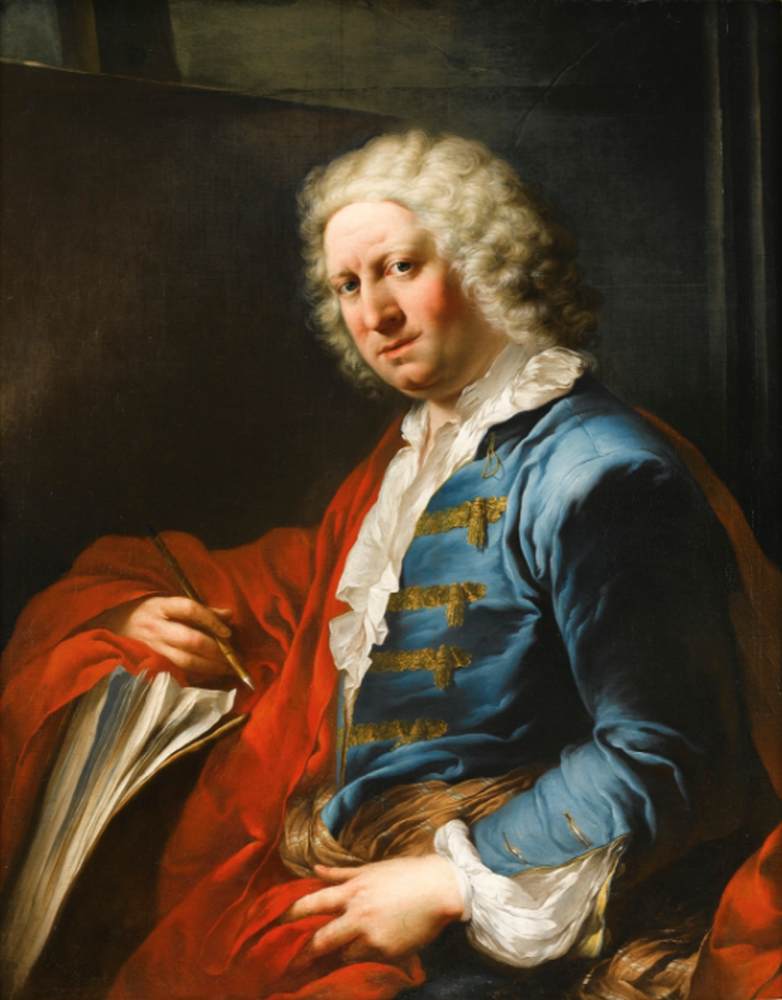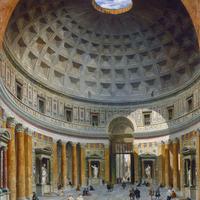More about Giovanni Paolo Panini
Works by Giovanni Paolo Panini

Contributor
The first challenge for Panini scholars is that they don't know if his name is Panini or Pannini, but they're mostly sure he was just one guy, with many areas of artistic practice, and that he probably did not invent a grilled sandwich.
The variation of the artist's name parallels a variation of the artist's medium, and an absence of biography gives us little more than the works for telling a story. Like Warhol and da Vinci, Panini was a Catholic artist successful in many different professional fields. Panini's areas included fresco painting, interior design, architecture, portraiture, the veduta or landscape, and probably a number of other things, like fundraising, mingling, and writing polite letters.
Panini, "a painter of architectural capricci and vedute, was the heir to the Bolognese Baroque tradition of quadratura, or illusionistic architectural painting." The words are unique: the capricci are architectural fantasy paintings, depicting a scene with the use of impossible visual perspectives, exaggeration, and other cartoonish techniques, and the vedute are "views" or landscapes, like those of Canaletto. Quadratura created "fictive space" through painting on the interior of a building. Caesar's Palace in Las Vegas uses quadratura to make it look like you are outdoors. Quadratura was also practiced by Veronese and Andrea Pozzo.
If you're a geometry nerd, it's good to note that one of the methods of quadratura is anamorphosis, which is an artistic use of affine transformations, which scale, translate, transform, reflect and rotate spaces while maintaining relationships between points, lines, and planes.
Like Bernini, after his studies, Panini eventually became principal of the Accademia di San Luca, which has existed for over four centuries. His first signed work is an undated depiction of the "flight into Egypt," held by a private collector in Genoa. His last signed work is The Colosseum (1764; Prague, N.G., Šternberk Pal.).
Sources
- Arisi, Ferdinando. Gian Paolo Panini e i fasti della Roma del ’700. Rome: U. Bozzi, 1986.
- "Gian Paolo Panini." Museo Thyssen, https://www.museothyssen.org/en/collection/artists/panini-gian-paolo.
- "Giovanni Paolo Panini." The J. Paul Getty Museum, https://www.getty.edu/art/collection/artists/642/giovanni-paolo-panini-….
- Landini, Gabriel. "Fractal anamorphosis: Look up table transform using self-affine series." Computers & Graphics 21, no. 1 (1997): 105-111.
- Marshall, David R. "La tentation néoclassique: les plafonds peints romains de Panini à Mengs." In Jean-Marc Olivesi, ed., ‘Les Cieux en Gloire’. Bozzetti et modelli pour les eglises et les palais de la Rome Baroque (Ajaccio, France: Musee Fesch, 2002): 37
- Minor, Vernon Hyde. Passive Tranquillity: The Sculpture of Filippo Della Valle. Philadelphia: American Philosophical Society, 1997.
Featured Content
Here is what Wikipedia says about Giovanni Paolo Panini
Giovanni Paolo, also known as Gian Paolo Panini or Pannini (17 June 1691 – 21 October 1765), was an Italian Baroque painter and architect who worked in Rome and is primarily known as one of the vedutisti ("view painters"). As a painter, Panini is best known for his vistas of Rome, in which he took a particular interest in the city's antiquities. Among his most famous works are his view of the interior of the Pantheon (on behalf of Francesco Algarotti), and his vedute—paintings of picture galleries containing views of Rome. Most of his works, especially those of ruins, have a fanciful and unreal embellishment characteristic of capriccio themes. In this they resemble the capricci of Marco Ricci. Panini also painted portraits, including one of Pope Benedict XIV.
Check out the full Wikipedia article about Giovanni Paolo Panini











